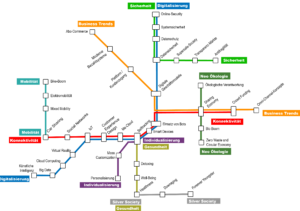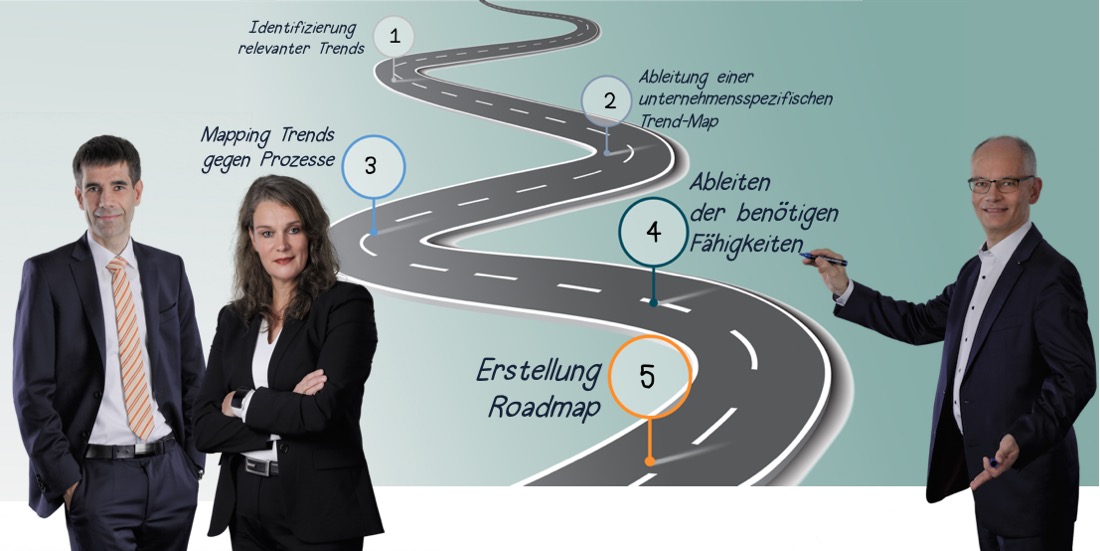“trend2ability” is a method developed by us on the basis of project experience, which serves to derive the required business capabilities from the trends relevant for a company. The entire spectrum of trends, from megatrends to technical trends, is taken into account. The goal is to identify the skills required to make sustainable use of trends in the sector-specific value chain of companies. This article deals with the concrete implementation of the trend2ability method. To this end, we break down the procedure into five steps, present prime examples of trend2ability projects already implemented and point out the potential with regard to visualisation and possible applications.
Step 1: Identify relevant trends
In our blog post “Business Capabilities – the key to adapting trends” we have described the types of trends that affect companies. The first step is to determine at which point in a company’s business model a trend or one of its subtrends “starts”. In line with the St. Gallen business model of the information age, a trend can set in at the levels of strategy, business processes and technology/IT. Effects of trends are usually cross-level. Then it is necessary to consider the degree of maturity of the corresponding skills in the company at the respective point of approach.
Only if the respective influence of the trend on relevant processes of the company is high and the discrepancy between company status and state of the art is relevant, the trend and influenced process are considered further. These are the parameters on which change processes can be “calibrated”. Special attention needs to be paid to trends for which there are no corresponding processes in the company yet.
Step 2: Derivation of the company-specific trend map.
If the results are consolidated at trend level, a company-specific trend map can be generated. This will map corresponding trends with their subtrends in lines similar to a subway map. Nodes are created by cutting different trends with their subtrends. The nodes represent subtrends that are part of several trends.

Step 3: Mapping trend against processes
In the first step, the intersections of trends with processes, business models and IT were defined as nodes in the sense of superordinate adjusting screws. In the next step, the possibilities of “fine-tuning” are examined in more detail at the sub-process and subtrend level and a voting is carried out regarding the importance and the design options. The two main questions here are:
- Where is there a need for action?
- What effect does a change at this node have if something is changed?
The result is documented in a matrix.
Step 4: Derive the required skills
The required capabilities are now determined for the set screws determined in the previous step. One example is the megatrend of individualization / mass customization:
The company wants to offer a product with different variants in order to be able to offer a differentiated range on the market. Based on the fourth step of the trend2ability method, the following process results:
- Product development wants to develop a product with many variants.
- Product development wants to virtually secure a product with many variants in order to reduce physical prototypes and shorten the development time.
- Product development wants to map a product with many variants in the PDM in order to document the development and to be able to make the data available to downstream areas.
- Sales wants to configure a product with many variants in order to optimize the sales process.
At this level, time and effort can already be roughly estimated. Synergy effects are also visible. This is an important basis for the next step.
Step 5: Roadmap and planning
This step begins with the prioritization of skills. The common 50-30-20 rule can be used for prioritization. Adapted to the topic of Capability Management, it states that 50 percent of time and budget should be invested in the development of very significant skills, 30 percent in the development of significant skills and 20 percent in the development of less significant skills.
For visualization purposes, the prioritized capabilities can be mapped in a roadmap. The roadmap specifies at the quarterly or monthly level which capability will be available at which point in time. This is not project planning, but the basis for planning projects, which can now take place.
During planning, on the one hand, the sum of all partial capabilities that are necessary for a capability as a whole must always be considered. On the other hand, new projects cannot be started for all capabilities. Therefore, it is considered:
- What must be implemented as a project?
- What else can be incorporated into existing projects?
- What can be controlled into the line?
In the case of IT measures, these questions arise accordingly:
- Where is a change to an existing system sufficient?
- Where do I have to wait for a new release?
- Where is there no IT solution yet?
trend2ability and its applications
The theoretical-chemical outline of the five-step procedure and the various practical examples demonstrate how comprehensively the trend2ability method can be used. It is suitable both for looking at individual megatrends and for looking at all trends that affect a company.
To get to know the method, we recommend starting with one or two trends: In this way you first gain a necessary feeling for the trend2ability method for your company, acquire a certain routine and thus systematically work towards securing the future viability of your company.
(Cover picture: © Patrick Mueller / background: © SceneNature | AdobeStock)

